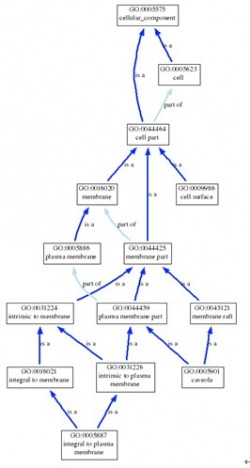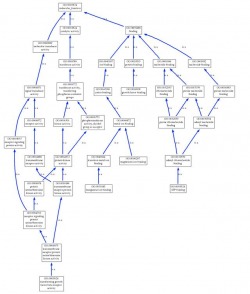This web page was produced as an assignment for Genetics677, an undergraduate course at UW-Madison.
Gene ontology
I used GO to illustrate an interaction network of cellular function of my gene BMPR 2. I used my full sequence of protein to analyze gene ontology. This figure represents as a chain analysis that starts with a few big groups of functions and go further divide within each group. First category is the protein being integral to plasma membrane. Because BMPR2 is a protein receptor that binds with BMP ligans and trasfer its signaling to inside of cell (Morrell 2006).
Molecular process
Molecular process
Molecular function of the gene BMPR2 in pulmonary arterial hypertension can be divided into three: transforming growth factor beta receptor activity (GO: 0005024), manganese ion binding (GO: 0030445), and ATP binding (GO: 0005524). These three molecular functions are pretty much expected because the protein from the gene BMPR2 has main domain of protein kinase. This is for ATP binding site for phosphorylation. According to Morrell, protein kinase domain plays an important role in this BMPR2 signlaing pathway that it phorphorylate BMPR1 to activate. By doing this, they need ATP for a phosphate group (2006). Therefore, all three functions listed from molecular GO confirms that its role as in receptor.
Biological process
Biological process
Overall AmiGo gives nice figures to represent its functions of cellular, molecular, and biological process. Because there are so many things are involved together, it was hard to see or to read figures at once.
Therefore, I accessed Uniprot to obtain more organized data about this gene ontology.
For summary of the role of the protein in three categories, please read followings (Red- important process in BMPR2 signaling pathway):
Following information retrieved from Uniprot
Cellular process
Integral to plasma membrane
Molecular process
ATP binding
magnesium ion binding
manganese ion binding
transforming growth factor beta receptor activity
Biological process
BMP signaling pathway
anterior/posterior pattern formation
cellular response to starvation
lung alveolus development
mesoderm formation
negative regulation of cell growth
negative regulation of systemic arterial blood pressure
negative regulation of vasoconstriction
positive regulation of BMP signaling pathway
positive regulation of bone mineralization
positive regulation of endothelial cell migration
positive regulation of endothelial cell proliferation
positive regulation of epithelial cell migration
positive regulation of osteoblast differentiation
positive regulation of pathway-restricted SMAD protein phosphorylation
regulation of lung blood pressure
transcription from RNA polymerase II promoter
vascular endothelial growth factor receptor signaling pathway
It was hard to view the gene ontology map, especially for biological process, because there are so many processes that are involved with. There are a few important processes I would like to emphasize from above list. The role of BMPR2 is associated negative regulation of cell growth. I guess the meaning refers that there would be no more cell growth if there are many. Because mutated BMPR2 stimulates the proliferation of smooth muscle cells according to my primary scientific journal I reviewed, this biological process is likely to associate with the proliferation of smooth muscle cells in pulmonary arterial hypertension (PAH) state. In addition, many biological processes are related with causes or consequences of PAH, such as blood pressure, endothelial cell proliferation, regulation of lung blood pressure, or vascular endothelial growth factor receptor signaling pathway.
Therefore, I accessed Uniprot to obtain more organized data about this gene ontology.
For summary of the role of the protein in three categories, please read followings (Red- important process in BMPR2 signaling pathway):
Following information retrieved from Uniprot
Cellular process
Integral to plasma membrane
Molecular process
ATP binding
magnesium ion binding
manganese ion binding
transforming growth factor beta receptor activity
Biological process
BMP signaling pathway
anterior/posterior pattern formation
cellular response to starvation
lung alveolus development
mesoderm formation
negative regulation of cell growth
negative regulation of systemic arterial blood pressure
negative regulation of vasoconstriction
positive regulation of BMP signaling pathway
positive regulation of bone mineralization
positive regulation of endothelial cell migration
positive regulation of endothelial cell proliferation
positive regulation of epithelial cell migration
positive regulation of osteoblast differentiation
positive regulation of pathway-restricted SMAD protein phosphorylation
regulation of lung blood pressure
transcription from RNA polymerase II promoter
vascular endothelial growth factor receptor signaling pathway
It was hard to view the gene ontology map, especially for biological process, because there are so many processes that are involved with. There are a few important processes I would like to emphasize from above list. The role of BMPR2 is associated negative regulation of cell growth. I guess the meaning refers that there would be no more cell growth if there are many. Because mutated BMPR2 stimulates the proliferation of smooth muscle cells according to my primary scientific journal I reviewed, this biological process is likely to associate with the proliferation of smooth muscle cells in pulmonary arterial hypertension (PAH) state. In addition, many biological processes are related with causes or consequences of PAH, such as blood pressure, endothelial cell proliferation, regulation of lung blood pressure, or vascular endothelial growth factor receptor signaling pathway.
Reference
[1] Morrell, N. (2006) Pulmonary Hypertension Due to BMPR2 Mutation. Proc Am Thorac Soc3, 680-686. doi: 10.1513/pats.200605-118SF
[1] Morrell, N. (2006) Pulmonary Hypertension Due to BMPR2 Mutation. Proc Am Thorac Soc3, 680-686. doi: 10.1513/pats.200605-118SF



